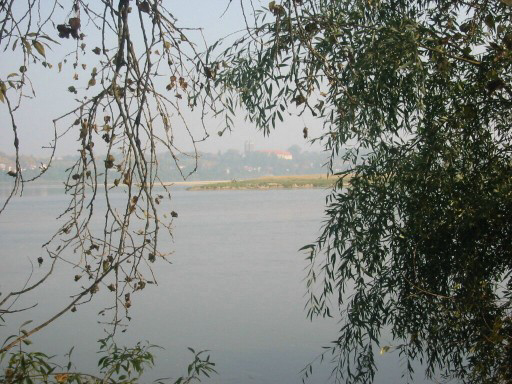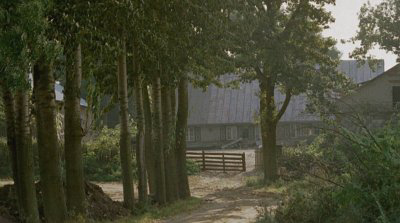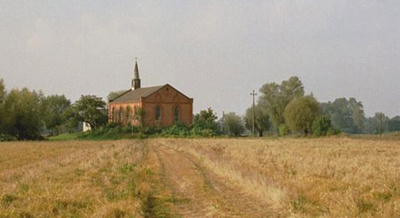 |
 |

|
Niedrunger Villagesby Annegret Krause - translated by Paul Work |
Thursday, 3 October 2002"You have to find the Kaiserstrasse." Before our departure I had asked my Aunt Amanda about her hometown of Wionczemin. "That's where my farm and that of the Krause's is located." She qualified that by adding: "Well, today the road is probably called something else". Of course! Our destinations today were the former German settlements near Płock. Here, in Zyck, Wionczemin, Sady, Troszyn, Nowosiadło etc., some of my ancestors lived out their lives for almost 200 years. They were Dutch, Poles, Huguenots from Salzburg, and settlers from Brandenburg. And now a little bit of explanation: Beginning in the Middle Ages several waves of western European immigrants settled in this area of Poland. In the 16th century, they recruited the Dutch to settle the low-lying areas around the Vistula so they could make the swampy areas next to the river arable. The Dutch were familiar with the techniques necessary to convert the land: they built levees, dug ditches to drain the land, and above all, bred cattle for dairy farming. Many years later people still called the settlements that were laid out in this way "Hollaendereien" (which meant "after the manner of the Dutch"), even if the inhabitants could no longer trace their roots back to Holland. These areas were uninteresting for the Polish landlords, so the settlers, unlike the Polish peasants, were not forced into being serfs, but were relatively free to work their farms. The desire for freedom from serfdom was also the driving force for further settlement waves. German farmers escaping feudal rule in Germany, or those second, third, or later sons of free farmers (with no rights to inheritance) came to Poland seeking freedom and an escape from social decline. Many also came for reasons of belief: Protestants from Austria, Holland and Germany. The requirements were light: A prospective settler had only to explain his intentions and describe the goods or produce he intended to develop on the farm. He was then assigned a piece of land at a low price. Which section of land a settler was assigned depended on his origin and his experience with the soil found in the area: land in a flood plain or the lighter soils found at higher elevations where the land was wooded. Each settler was given a set of conditions, for example contributing to the building of levees and paths, laying out orchards, etc. In all other respects, the settler was free to run the farm as he saw fit. After twelve years he would receive full ownership with all the associated rights (selling, inheritance). In this fashion, more and more German colonies were founded throughout the low-lying areas, working their way up the Vistula over the years. This pattern carried on into to the 19th century, with the German settlements segregated from the Polish villages. Wionczemin Niemiecki was founded in 1759, Secymin Niemiecki about 1800. The settlers kept up their language, built schools and Protestant churches, and they showed little tendency to assimilate themselves with the native Polish people. At the Congress of Vienna in 1815, Central Poland was designated as the "Kingdom of Poland", in personal union with the Czar of Russia as the King. For all intents and purposes, however, it belonged to Russia until the end of WW I. That meant that the German settlers also had to serve in the Russian army. Initially the official language was Polish until 1868, and Russian from then until the end of WW I. The church books were correspondingly written in either Polish or Russian, the latter even in the old Cyrillic script. That makes the research much more difficult. That's it, very briefly, about the historical background. On our trip first we came to Sladów, an extended row house development along the levee. B., to whom I'm distantly related by marriage, and who provided me with many facts about my family, had told me, that there should be an old cemetery at the end of the village. If it still existed, it would be overgrown by bushes or trees. When the Germans had to leave Poland towards the end of WW II, there was no one left to take care of the graveyards and so nature had taken possession of them. We kept our eyes peeled for any overgrown area near the village, but there wasn't anything that looked like an unkempt cemetery. So we turned towards the levee and found a large monument. It loomed up in front of the levee, and some simple benches sat in front of it. We imagined school classes, gathered around, listening to their teachers' stories. The inscriptions on the monument honor the inhabitants of the village and the soldiers who lost their lives in September 1939 fighting the invading German troops. The German troops had reached this area in the first weeks of the war, and in this region north of Kutno they concluded the "Blitzkrieg", which ended with the defeat of Poland and – according to the Non-Aggression Pact between Hitler and Stalin – resulted in another partition of Poland, this time between Germany and the USSR. After existing for only 21 years a sovereign Polish state, this country had once more disappeared from the political map of Europe. During the years of war that followed, Poland lost 17 % of its population, more than any other country in the world. Outright murder, extermination in concentration camps, casualties of the German bombing raids, forced labor and deportation to Siberia took their toll on the Polish people. Of the 2 million Poles, who were deported to Siberia, for example, less than half survived the first year. As we stood at such places, we began to wonder if we were perhaps a little naïve in our search for traces of our ancestors. Would we be reopening old wounds? We didn't know what kind of reception we would get. But S. might be a good judge of that ("They are feeling friendly!"). We walked along the levee for a bit, enjoying the breadth of the countryside in the unbelievably warm autumn weather. On the bank we took some photos of this wonderfully beautiful river. Pictures such as these should be framed! An old apple tree had lavishly given away its fruit, many apples lay there in the grass, red and appetizing. We picked up some of them. They tasted very sweet, having very little acid. What a pity, we didn't think of taking some back to Aunt Amanda; perhaps she would have recognized the type.
The Vistula near Sladów - Photo by Annegret Krause, 2002 Our next stop was Wyszogród, also situated on the steep bank on the opposite side of the river. It's a small sleepy town. We would have liked some coffee, but we could find neither a bar nor a café. There are two churches in Wyszogród. At one of them we took a closer look and sure enough, it was the former Lutheran church (an info sheet confirmed our speculation). Here too, relatives of mine were married, probably my grandparents too. Next to the church we saw an overgrown piece of land. I discovered a small iron cross, rising up out of the bushes. A cemetery? That's what we wanted to know. And there it was, beneath the undergrowth, in a jungle of nettles and blackberry bushes we found a few grave borders and some gravestones with German inscriptions. But the names were meaningless to us. We found another monument on the north end of the bridge by Wyszogród and a map posted by the monument gave us more detail about the battles from the 17th to the 19th of September 1939. It must have been a real hell. What kind of behavior did the Germans who were living here at that time display? That's a difficult question that even the Polish and German historians struggle to answer. An attempt to explain in this abbreviated format runs the risk of oversimplification and may provoke the one or the other side to disagree vehemently. But it is necessary, and I want to try in spite of the difficulty: If one believes the reports published on this subject, between WW I and WW II the German settlers obeyed the laws of the new Polish state, just as they had done while under Russian rule prior to WW I. They served in the Polish army and some of them even fought against the invading German troops. Nevertheless there were – from this distance – tendencies towards an idealized image of Germany. During the thirties the tensions between Poles and ethnic Germans increased. People, who up to that time had been good neighbors, began to feel increasingly threatened by the other side. This increasing tension eventually led to the murder or kidnapping of ethnic Germans immediately prior to and shortly after the war began, but not on the scale that the Nazi propaganda broadcast (which was used as one of the excuses for invading their neighboring country). At first, many of the ethnic Germans in Poland greeted the invasion of the German army as a welcome release from the life-threatening situation. Later, as the Nazi demagogues with their unspeakable and incomprehensible injustices replaced the troops, many of them distanced themselves again. A quote from a spiritual leader in Posen illustrates this: "We were looking forward to the arrival of the Germans and we greeted them cheerfully, but what we got were the Nazis, and they are not the Germans that we had known." And therein lies the question that grew out of the occupation of Poland. What was the relationship between the "superior race" as defined by the Nazis and the "sub-humans"? Many of the ethnic Germans also experienced the reverse of this in 1939 and again at the end of WW II when the Poles viewed them as representatives of the Nazis. They felt the bitterness and the often-bloody revenge of the Poles. There was horrible suffering on both sides! So many difficult, depressing questions, and we still can't answer them adequately. But it was getting close to noon, and we still wanted to visit Wionczemin! So we crossed the bridge again and turned right on the 575, which connects Płock with Warsaw along the south side of the Vistula. The first larger town was Iłów, which, next to Gąbin (which we unfortunately didn't have time to visit), was one of the few Lutheran congregations in the area for a many years. The church was, like nearly all churches in Poland, in excellent condition structurally. (Note: It was the catholic church. The Lutheran Church does not exist anymore) We took a quick look inside: Here marriages and christenings were celebrated. Funerals, however, were carried out in local cemetery chapels. In a small shop we bought supplies for a little picnic, and then we traveled on. In Wymyśle Polskie we turned right again towards the Vistula. The small road took us through Juliszew, Sady, Nowosiadło, and Swiniary to Wionczemin, names that I knew very well as the birthplaces, homes, and burial places of my great great grandparents and their families. Wionczemin. We needed to find the Kaiserstrasse! At first glance the task appeared hopeless and absurd. We found only tracks through the fields and occasional houses, all part of the sad remains of a dilapidated collective farm, the Polish equivalent of the LPGs in the former East Germany. One other clue that we heard over the telephone after we left was that the old German church could serve as a landmark. We could see the church across the fields, and we tried to drive closer. We tried several paths through the fields, but after a little while we gave up. Every path that we tried ended in a field or got too rough for the car. There must be a way to get to the church, said Hannes. Yes, there should be you would think. We pulled back and decided to try an approach using the levee road. As we went along, we decided to pause and check out the banks of the river. Again, we were enchanted with the beauty of the river and the land in front of the levee. Across from us lay an island, known as a Kępa in Polish. This island had also been tilled earlier, and some of the islands had also been inhabited. In the summer the cows and horses were brought to the sweet meadows of the islands explained Aunt Amanda. Not with a raft! No, she said, the animals can swim. The farmer simply tied the lead cow's tether to a rowboat and the rest of the herd simply followed obediently, swimming next to the boat in a well-behaved manner.
Farm at Troszyn - Photo by Annegret Krause, 2002 As we followed the levee road further, we were unable to find an intersecting road that led to the church. Instead, we arrived at the neighboring villages of Troszyn Nowy (formerly known as Deutsch Troszyn) and Troszyn Polski, which lies on the way back to Wionczemin. Our final attempt to reach the church by car ended in frustration, and we finally parked it on the side of the road, choosing to approach the church on foot.
The church at Wionczemin - Photo by Annegret Krause, 2002 As we got nearer, we saw that there really was no road that led to the church, only a footpath across a pasture. The small brick church stood in the middle of the fields without a proper road leading to it, and it was clear that it was no longer in use. Right next to it stood an old, somewhat run-down house, perhaps the former rectory? (Note: It's the former school) |


